Kingdom Animalia Class Insecta | Phylum Arthropoda Genus Chilo Rank Species | |
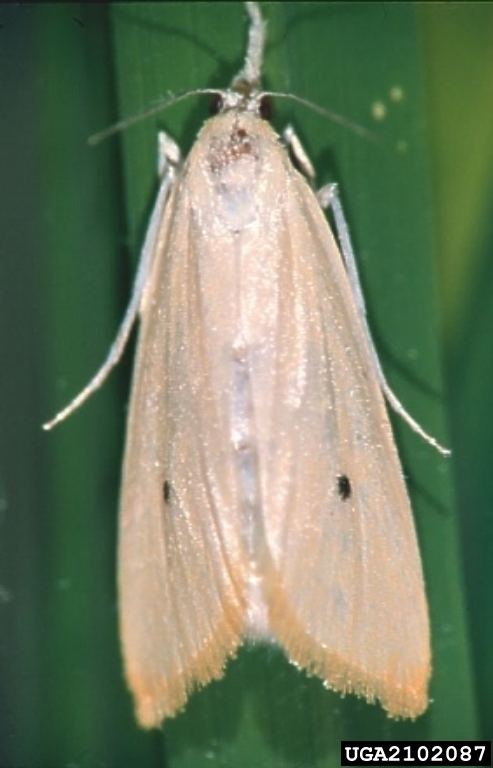 | ||
Similar Chilo, Sesamia inferens, Scirpophaga incertulas, Scirpophaga, Cnaphalocrocis medinalis | ||
The Asiatic rice borer or striped rice stemborer (Chilo suppressalis) is a moth of the Crambidae family. It is a widespread species, known from India, Sri Lanka, China, eastern Asia, Japan, Taiwan, Malaysia to the Pacific.
Contents

It is a serious pest of rice they are largely responsible for the great reduction in the rice growing in East Asia, India and Indonesia. It was probably introduced in Spain and Hawaii by humans, where it is widely spread towards Northern Territory of Australia.
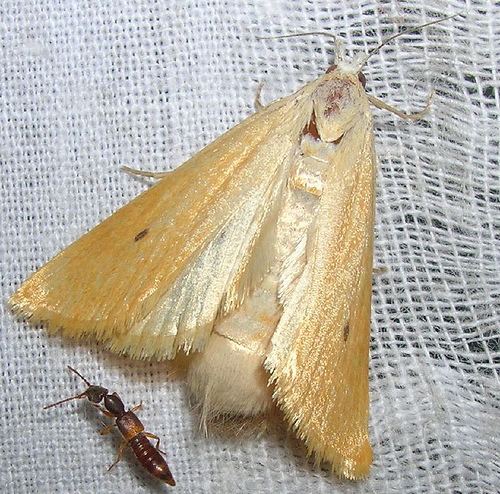
Description
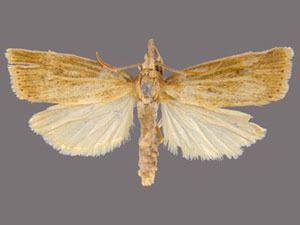
The wingspan is 18 mm in male and 18-20 mm in female. In male, head and thorax brown and white. Abdomen pale. Fore wings with somewhat acute apex which is ochreous, wholly suffused with brown except a patch in cell and a streak below medial nervure. Inner margin whitish. A sinuous rufous medial line runs with silvery spots on its inner side, also on discocellulars, and below vein 2. A rufous submarginal line, highly angled at vein 6 and with silvery line on its outer edge. A marginal series of black specks found. Cilia rufous. Hind wings whitish.
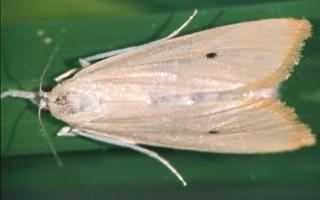
In female, it is much more orange fulvous colored. Fore wings irrorated with brown. Medial and submarginal lines almost obsolete. The silvery spots below the cell prominent and sometimes double. The postmedial area irrorated with silvery scales.
Ecology and Life cycle
Eggs are scale-like and translucent-white to dark-yellow. These naked clusters consist of nearly 60 overlapping rows.
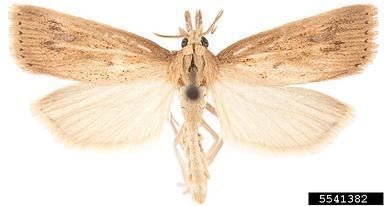
First instar larvae are greyish white with a black head. Hea capsule gradullay turns brown towards final stages. Full grown larvae are yellow, with five, dim, longitudinal lines, and can grow to a length of about 25 mm.

Apart from major food plant rice, larvae also feed on wide array of cultivations such as Gigantochloa verticellata, Echinochloa crusgalli cruspavonis, Echinochloa stagnina, Eleusine indica, Panicum sp., Paspalum conjugatum, Amaranthus sp., Phragmites australis, Raphanus raphanistrum, Sclerostachya fusca, Sorghum sp., Typha latifolia, Xanthium strumarium, and Zizania aquatica.
Pupation takes place in a stem of the food plant. Pupae are reddish-brown with two ribbed crests on the pronotal margins. Several spines are located in the cremaster on the last abdominal segment.
Attack
They bore the stems of their host plants, and therefore are classified as rice stem borers.
Almost all plant parts from twigs, leaves, stems are attacked. Caterpillars can be largely internal feeders, whereas adults are external sap feeders. Heavily attacked plant can show varying symptoms from dead heart, white heads, dwarfing, stunting, rot, abnormal forms, and rosetting. Finally the whole plant will dieback. Dead hearts are the most obvious field symptoms.
Prevention
The pest should diagnose early in the symptoms, unless it is not worthy to protect the cultivation. Many traditional and agricultural practices like flooding and harrowing or ploughing to turn in stubble and straw are effective to prevent pests in the next growing season. The use of early-maturing varieties and at harvest, planting synchronization and stem removal close to ground is managed.
Biologically, they can easily removed by usage of tachinid Paratheresia claripalpis, which is extensively practiced in Malaysia. The ichneumonid Eriborus sinicus, also used in many Asian to Hawaii people.
Planting highly resistant varieties of rice and transgenic plants is also known to reduce the attack of these pests.
